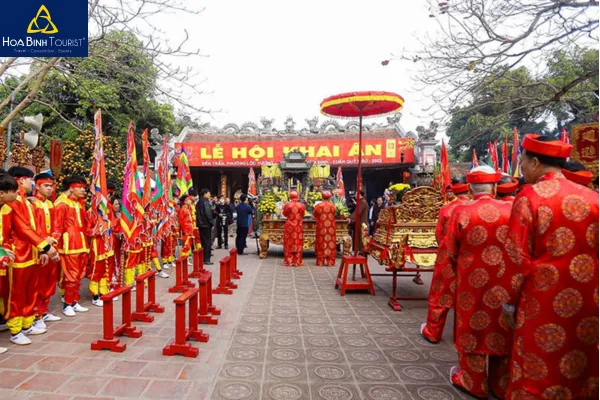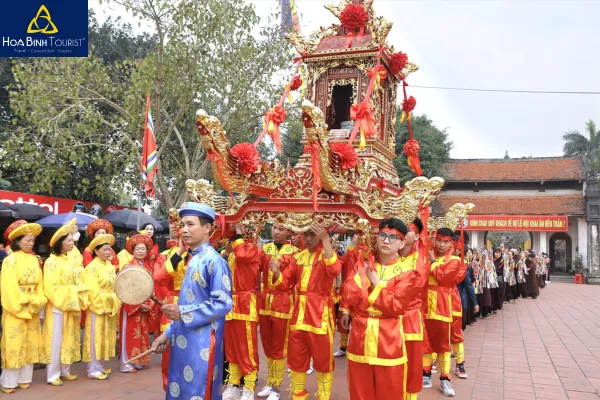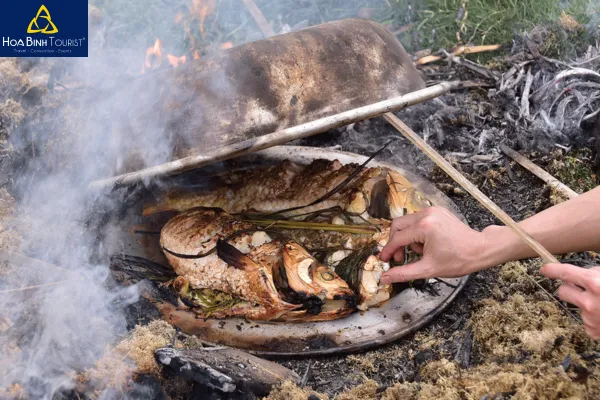Tran Temple in Nam Dinh, a sacred place imbued with the spirit of the nation, is not only a renowned pilgrimage destination but also the venue for unique festivals deeply rooted in Vietnamese culture. Visiting the Tran Temple Festival is not merely a journey to explore historical relics, but also a profound spiritual and cultural experience, bringing each person back to their origins, honoring ancestors, and immersing themselves in the jubilant festival atmosphere.
Discovering Tran Temple: Tracing Back to a Glorious Dynasty
Tran Temple – Witness to Golden History
Located in Loc Vuong Ward, Nam Dinh City, Tran Temple stands majestically on the land that was once Thien Truong Palace, the second capital of the Tran Dynasty. This place is dedicated to the worship of 14 Tran Dynasty emperors and prominent mandarins and generals who contributed to the heroic history of resisting Mongol invasions. Built in 1695, Tran Temple is not only an ancient architectural work but also a symbol of patriotism, indomitable will, and national pride.

Stepping into Tran Temple, visitors feel like they are entering a sacred space where past and present intertwine. The moss-covered roofs, the solemn rows of ironwood columns, the intricate carvings… all evoke a glorious historical period, a dynasty that built the brilliant Dai Viet civilization.
The Mark of Thien Truong Palace – The Second Capital of Dai Viet
Thien Truong Palace, the predecessor of Tran Temple, was once an important political, economic, and cultural center, second only to Thang Long Imperial City. This place witnessed many significant historical events, especially during the first resistance war against the Mongol invaders in 1258. At that time, King Tran Thai Tong decided to withdraw troops from Thang Long to Thien Truong Palace to preserve forces, implement the “empty garden, empty house” strategy, and prepare for a strategic counter-attack.
At Thien Truong Palace, on the 14th day of the first lunar month, King Tran Thai Tong held a grand banquet, rewarding and bestowing titles upon meritorious generals and soldiers. Along with this, the seal opening ceremony was held, with the meaning of praying for a new year of national prosperity, peace, and favorable weather. From this historical event, the Tran Temple Seal Opening Festival has become a traditional custom, a unique cultural beauty of Nam Dinh and the whole country.
Experiencing the Tran Temple Festival: Immerse Yourself in a Unique Spiritual Culture
Tran Temple is famous for two major festivals: the Seal Opening Festival in the first lunar month and the August Festival. Each festival has its own unique beauty, but both are opportunities to commemorate the merits of the Tran kings, pray for luck and peace, and express precious traditional cultural values.
Tran Temple Seal Opening Festival: Praying for New Year Blessings and Prosperity
Taking place on the night of the 14th and the 15th of the first lunar month, the Tran Temple Seal Opening Festival is one of the largest and most important festivals in Nam Dinh. The highlight of the festival is the seal opening ritual held at the hour of Ty (1:00 AM) on the 15th. The seal is opened with the desire to pray for a new year of national prosperity and peace, and for everyone to receive blessings and fortune.

People and visitors from all over the country come to Tran Temple during the Seal Opening Festival not only to attend the ritual but also to ask for a seal. The Tran Temple seal with the four characters “Tich phuc vo cuong” (Accumulating boundless blessings) carries a profound educational meaning about cultivating morality and accumulating merit to enjoy lasting blessings. Asking for a seal at the beginning of the year has become a cultural beauty, a traditional custom expressing the wish for a new year of peace, luck, and success.
In addition to the seal opening ceremony, the festival also has many other traditional activities such as:
- Ngoc Lo Palanquin Procession: Carrying the incense burner of Buddha Emperor Tran Nhan Tong from Pho Minh Pagoda to Tran Temple, showing respect for ancestors and requesting witness for the seal granting ceremony.
- Water Procession – Fish Offering Ceremony: Recreating the traditional rituals of riverine residents, commemorating the thủy tổ (water ancestor) origin of the Tran Dynasty.
- Upper Nguyen Tet Offering Ceremony on the full moon of the first lunar month: Praying for peace and luck for oneself and family in the new year.
Tran Temple August Festival: Vibrant Colors of Traditional Culture
The Tran Temple August Festival takes place from the 15th to the 20th of the eighth lunar month, as an opportunity to commemorate the merits of the Tran kings and honor traditional cultural values. The festival is solemnly organized with palanquin processions, offerings, incense offerings… The festival part is a unique cultural and artistic space with many rich and attractive activities.

The highlight of the August festival is the palanquin procession from surrounding communal houses and temples to Thien Truong Temple to offer incense and worship. The incense offering ceremony is performed by 14 virgin girls, recreating the courtly manner of the old dynasty. The festival part brings a joyful and bustling atmosphere with folk cultural activities such as chicken fighting, martial arts performances, wrestling, lion dances, chess playing, bamboo bridge swinging, “hat van” singing, and “mua bai bong” dancing. These activities not only contribute to preserving and promoting traditional cultural values but also create a special attraction for the festival, attracting a large number of tourists to visit and experience.
Complete Travel Experiences for the Tran Temple Festival
Ideal Time to Visit the Tran Temple Festival
The ideal time to experience the Tran Temple Festival is during the Seal Opening Festival in the first lunar month and the August Festival. However, if you want to avoid crowds, you can visit Tran Temple at other times of the year. Tran Temple is open to visitors all year round, each season with its own beauty. Spring, Tran Temple is brilliant with peach blossoms, summer is green with the shade of ancient trees, autumn is contemplative and ancient, and winter is quiet and solemn.
Getting to Tran Temple
Tran Temple in Nam Dinh is about 85km from Hanoi, with convenient transportation. You can travel by various means:
- Coach: Coaches are a popular and economical means of transport. You can catch a bus from bus stations in Hanoi such as Giap Bat, Nuoc Ngam. Travel time is about 2-3 hours.
- Private Car/Motorbike: If you want to be proactive about time and schedule, you can travel by private car or motorbike in the direction of Phap Van – Cau Gie highway, then follow National Highway 10 to Nam Dinh.
- Airplane: If you are far away, you can fly to Noi Bai Airport (Hanoi), then travel by coach or taxi to Nam Dinh.
Accommodation When Visiting Tran Temple Festival
In Nam Dinh, there are many accommodation options from luxury hotels to budget guesthouses and homestays. You can choose accommodation that suits your needs and budget. If you want to fully experience the festival atmosphere, you should book a room in advance, especially during the festival season.
Unique Cuisine When Visiting Tran Temple
Visiting the Tran Temple Festival is an opportunity not to be missed to enjoy the unique cuisine of Nam Dinh:
- Nam Dinh Beef Noodle Soup (Pho Bo Nam Dinh): The famous pho with rich broth, fresh beef, and soft pho noodles.
- Upside-down Pot Roasted Fish (Ca Nuong Up Chau): A unique specialty with a delicious, rich flavor, often appearing on holidays and Tet.

- Kenh Village Steamed Rice Rolls (Banh Cuon Lang Kenh): Thin steamed rice rolls with fragrant wood ear mushroom and meat filling, served with a characteristic sweet and sour dipping sauce.
- Savory Sticky Rice (Xoi Xiu): A popular breakfast dish with sticky rice, char siu, Chinese sausage, and rich sauce.
- Giao Thuy Fermented Pork Roll (Nem Nam Giao Thuy): Famous fermented pork roll with a distinctive flavor, often bought as a gift.
Important Notes When Visiting Tran Temple Festival
- Dress Code: Choose modest and polite clothing when visiting temples and pagodas. You should wear comfortable shoes for easy movement.
- Security: During crowded festivals, pay attention to personal belongings and avoid bringing valuable jewelry.
- Offerings: If you want to make offerings, prepare appropriate and sincere offerings. You can refer to vegetarian offerings, savory offerings, raw food offerings, savory offerings of mountain spirits, offerings to the fairy ladies and princes, offerings to Thanh Hoang (village tutelary god), and Thu Dien (god of earth).
- Cultural Etiquette: Maintain a respectful, polite, and civilized attitude when participating in festivals and visiting temples.
Conclusion: Tran Temple Festival – An Unmissable Cultural and Spiritual Experience
Experiencing the Tran Temple Festival is a journey back to the roots, exploring profound historical, cultural, and spiritual values. Not only will visitors admire ancient architecture, participate in traditional rituals, and enjoy unique cuisine, but they will also have the opportunity to immerse themselves in the jubilant and bustling festival space, feel the patriotism, national pride, and the beautiful traditional cultural features of the Vietnamese people. Come to Tran Temple to discover and experience these wonderful things!